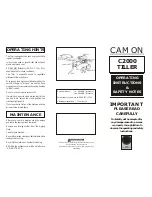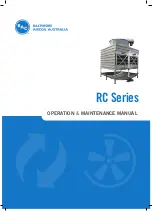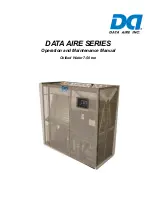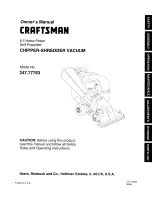
JOHNSON CONTROLS
FORM 160.75-O1 (309)
18
system components description
oil pump
For normal operation, the oil pump should operate at all
times during chiller operation.
On shutdown of the system for any reason, the oil pump
operates and continues to run for 150 seconds. The sys-
tem cannot restart during that time interval.
oil heater
During long idle periods, the oil in the compressor oil
reservoir tends to absorb as much refrigerant as it can
hold, depending upon the temperature of the oil and
the pressure in the reservoir. As the oil temperature is
lowered, the amount of refrigerant absorbed will be
increased. If the quantity of refrigerant in the oil be-
comes excessive, violent oil foaming will result as the
pressure within the system is lowered on starting. This
foaming is caused by refrigerant boiling out of the oil
as the pressure is lowered. If this foam reaches the oil
pump suction, the bearing oil pressure will fluctuate with
possible temporary loss of lubrication, causing the oil
pressure safety cutout to actuate and stop the system.
See “Control Center” Form 160.54-O1.
motor driVeline
The compressor motor is an open-drip-proof, squir-
rel cage, induction type constructed to YORK design
specifications. 60 hertz motors operate at 3570 rpm. 50
hertz motors operate at 2975 rpm.
The open motor is provided with a D-flange, cast iron
adapter mounted to the compressor and supported by a
motor support.
Motor drive shaft is directly connected to the compressor
shaft with a flexible disc coupling. This coupling has
all metal construction with no wearing parts to assure
long life, and no lubrication requirements to provide
low maintenance.
For units utilizing remote Electro-Mechanical starters,
a terminal box is provided for field connected conduit.
Motor terminals are brought through the motor casing
into the terminal box. Jumpers are furnished for three-
lead type of starting. Motor terminal lugs are not fur-
nished. Overload/overcurrent transformers are furnished
with all units.
heat exchangers
Evaporator and condenser shells are fabricated from
rolled carbon steel plates with fusion welded seams.
Heat exchanger tubes are internally enhanced type.
The evaporator is a shell and tube, flooded type heat ex
-
changer. A distributor trough provides uniform distribu
-
tion of refrigerant over the entire shell length. Stainless
steel mesh eliminators or suction baffles are located
above the tube bundle to prevent liquid refrigerant car-
ryover into the compressor. A 2" liquid level sight glass
is located on the side of the shell to aid in determining
proper refrigerant charge. The evaporator shell contains
dual refrigerant relief valves unless condenser isolation
is installed.
The condenser is a shell and tube type, with a discharge
gas baffle to prevent direct high velocity impingement
on the tubes. A separate subcooler (except heat recov
-
ery chillers) is located in the condenser to enhance
performance. Dual refrigerant relief valves are located
on condenser shells and optional refrigerant isolation
valves are available.
The removable compact water boxes are fabricated of
steel. The design working pressure is 150 PSIG (1034
kPa) and the boxes are tested at 225 PSIG (1551 kPa).
Integral steel water baffles provide the required pass
arrangements. Stub-out water nozzle connections with
Victaulic grooves are welded to the water boxes. These
nozzle connections are suitable for Victaulic couplings,
welding or flanges, and are capped for shipment. Plugged
3/4" drain and vent connections are provided in each
water box. Optional marine waterboxes are available.
refrigerant floW control
Refrigerant flow to the evaporator is controlled by a
variable orifice.
A level sensor senses the refrigerant level in the con
-
denser and outputs an analog voltage to the Microboard
that represents this level (0% = empty; 100% = full).
Under program control, the Microboard modulates a
variable orifice to control the condenser refrigerant
level to a programmed setpoint. Other setpoints affect
the control sensitivity and response. These setpoints
must be entered at chiller commissioning by a qualified
service technician. Only a qualified service technician
may modify these settings.
Содержание York MaxE YK Series
Страница 2: ...Page 2 of 2 ...
Страница 3: ......
Страница 4: ......
Страница 5: ......
Страница 6: ......
Страница 7: ......
Страница 8: ......
Страница 9: ......
Страница 10: ......
Страница 11: ......
Страница 12: ......
Страница 13: ......
Страница 14: ......
Страница 15: ......
Страница 16: ......
Страница 17: ......
Страница 18: ......
Страница 19: ......
Страница 20: ......
Страница 21: ......
Страница 22: ......
Страница 23: ......
Страница 24: ......
Страница 25: ......
Страница 26: ......
Страница 27: ......
Страница 28: ......
Страница 29: ......
Страница 30: ......
Страница 31: ......
Страница 32: ......
Страница 33: ......
Страница 34: ......
Страница 35: ......
Страница 36: ......
Страница 37: ......
Страница 38: ......
Страница 39: ......
Страница 40: ......
Страница 41: ......
Страница 42: ......
Страница 43: ......
Страница 44: ......
Страница 45: ......
Страница 46: ......
Страница 47: ......
Страница 48: ......
Страница 49: ......
Страница 50: ......
Страница 51: ......
Страница 52: ......
Страница 53: ......
Страница 54: ......
Страница 55: ......
Страница 56: ......
Страница 57: ......
Страница 58: ......
Страница 59: ......
Страница 60: ......
Страница 61: ......
Страница 62: ......
Страница 63: ......
Страница 116: ...FORM 160 75 O1 309 17 JOHNSON CONTROLS 3 FIG 6 schematic drawing yk compressor lubrication system LD08577a ...
Страница 135: ...JOHNSON CONTROLS FORM 160 75 O1 309 36 SI metric conversion ...
Страница 137: ...JOHNSON CONTROLS FORM 160 75 O1 309 38 NOTES ...
Страница 138: ...FORM 160 75 O1 309 39 JOHNSON CONTROLS NOTES ...
















































